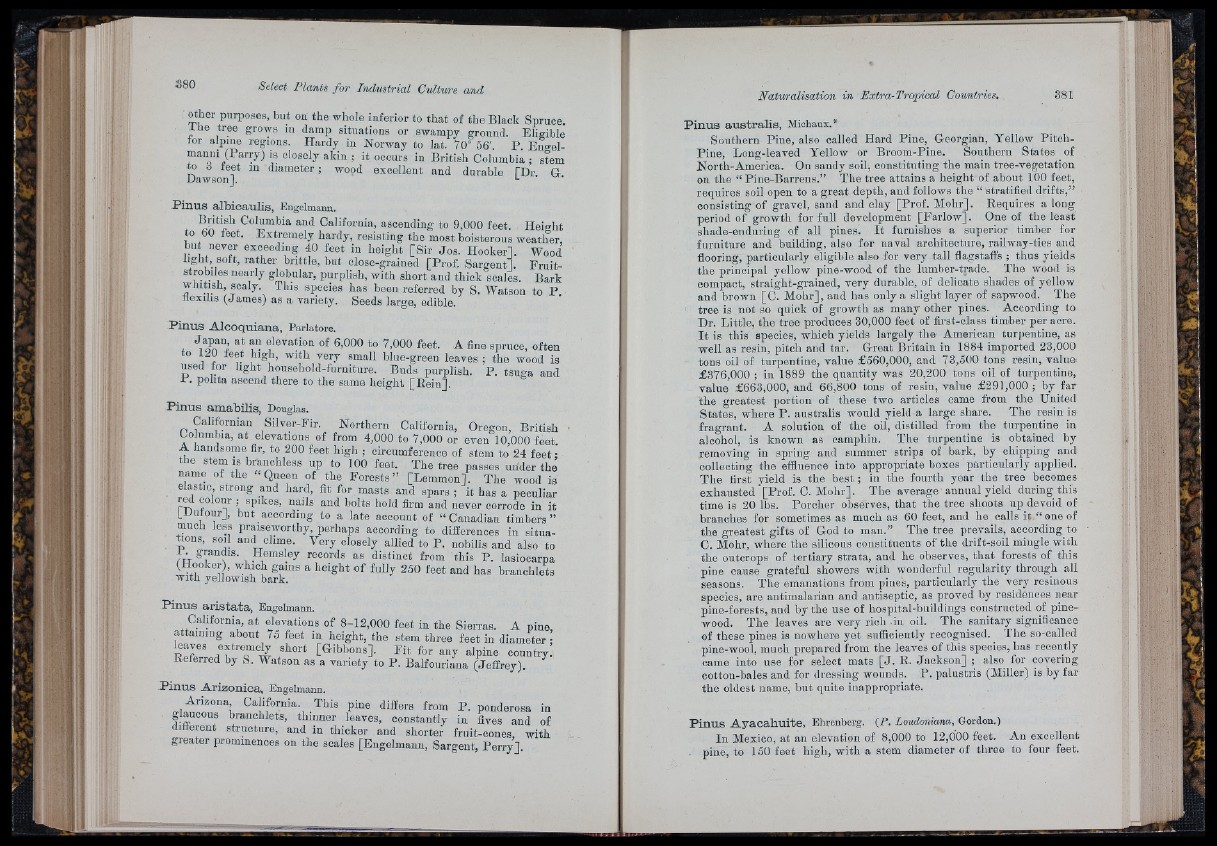
r ij
j
other purposes, but on the whole inferior to that of the Black Spruce.
Ih e tree grows in damp situations or swampj ground. Eligible
for alpme regions. Hardy in Norway to lat. 70° 56'. P. Engel-
manm (I arry) is closely akin ; it occurs in British Columbia ; stem
to d teet m diameter; wood excellent and durable TDr. G
Dawson]. '
Pinus albioaulis, Engelmana.
^ " * ‘7 Columbia and California, ascending to 9,000 feet. Height
to 60 feet. Extremely hardy, resisting the most boisterous weather,
but never exceeding 40 feet in height [S ir Jos. Hooker]. Wood
lighb soft, rather brittle, but close-grained [Prof, Sargent]. Fruit-
strobiles nearly globular, purplish, with short and thick scales. Bark
wJiitish scaly. Ib is species has been referred by S. Watson to P
nexilis (James) as a variety. Seeds large, edible.
Pinus Alooquiana, Parlatore.
Japan a t an elevation of 6,000 to 7,000 feet. A fine spruce, often
to 120 feri high, with very small blue-green leaves ; the wood is
used for hght houseliold-furnitiire. Bnds purplish. P. tsu sa and
P. polita ascend there to the same height [R e in ],
Pinus amabiUs, Douglas.
Californian Silver-Eir. Northern California, Oregon, British ■
Co umbia, a t elevations of from 4,000 to 7,000 or even 10,000 feet.
A handsome fir, to 200 feet high ; circumference of stem to 24 f e e t;
the stem IS branchless up to 100 feet. 'Phe tree passes under the
name of the Queen of the F o re s ts ” [Lemmon]. The wood is
elastic strong and hard, fit for masts and spars ; it has a peculiar
r ^ colour ; spikes, nails and bolts hold firm and never corrode in it
[Dufour], but according to a late account of “ Canadian timb e rs”
much less praiseworthy, perhaps according to differences in situations.
soil and clime. Very closely allied to P. nobilis and also to
r . grandis. Hemsley records as distinct from this P. lasiocarpa
(HookeQ, which gams a height o f fully 250 feet and has branchlets
With yellowish bark.
Pinus aristata, Engelmann,
California, a t elevations of 8-12,000 feet in the Sierras. A pine,
attaining about 7o feet m height, the stem three feet in diameter;
leaves extremely short [Gibbons]. F it for any alpine country!
Referred by S. Watson as a variety to P . Balfouriana (Jeffrey).
Pinus Arizonica, Engelmann.
Arizona California. This pine differs from P . ponderosa in
glaucous branchlets, thinner leaves, constantly in fives aud of
different structure, and in thicker and shorter fruit-cones, with
greater prominences on the scales [Engelmann, Sargent, P e rry ].
Naturalisation in Extra-Tropical Countries.
Pinus australis, Michaux.*
Southern Pine, also called Hard Pine, Georgian, Yellow Pitch-
Pine, Long-leaved Yellow or Broom-Pine. Southern States of
North-America. On sandy soil, constituting the main tree-vegetation
on the “ Pine-Barrens.” The tree attains a height of about 100 feet,
requires soil open to a great depth, and follows the “ stratified drifts,”
consisting of gravel, sand and clay [Prof. Mohr]. Requires a long
period of growth for full development [Parlow]. One of tlie least
shade-enduring of all pines. I t furnishes a superior timber for
furniture and building, also for naval architecture, railway-ties and
flooring, particularly eligible also for very tall flagstaffs ; thus yields
the principal yellow pine-wood of the lumber-trade. The wood is
compact, straight-grained, very durable, of delicate shades of yellow
and brown [C. Mohr], and has only a slight layer of sapwood. The
tree is not so quick of growth as many other pines. According to
Dr. Little, the tree produces 30,000 feet of first-class timber per acre.
I t is this species, which yields largely the American turpentine, as
well as resin, pitch and tar. Great Britain in 1884 imported 23,000
tons oil of turpentine, value £560,000, and 73,500 tons resin, value
£376,000 ; in 1889 the quantity was 20,200 tons oil of turpentine,
value £663,000, and 66,800 tons of resin, value £291,000 ; by far
the greatest portion of these two articles came from the United
States, where P. australis would yield a large share. The resin is
fragrant. A solution of the oil, distilled from the turpentine in
alcohol, is known as camphiu. 'The turpentine is obtained by
removing iu spring and summer strips of bark, by chipping and
collecting the efiluence into appropriate boxes particularly applied.
The first yield is the best ; in the fourth year the tree beoomes
exhausted [Prof. C. M o h r]. 'The average annual yield during this
time is 20 lbs. Porcher observes, th a t the tree shoots up devoid of
branches for sometimes as much as 60 feet, and he calls it “ one of
the greatest gifts of God to man.” The tree prevails, according to
C. Mohr, where the silicous constituents of the drift-soil mingle with
the outcrops of tertiary strata, and he observes, th a t forests of this
pine cause grateful showers with wonderful regularity through all
seasons. 'The emanations from pine's, particularly the very resinous
species, are antimalarian and antiseptic, as proved by residences near
pine-forests, and by the use of hospital-buildings constructed of pine-
wood. 'The leaves are very rich -in oil. 'The sanitary significance
of these pines is nowhere yet sufficiently recognised. ^ 'The so-called
pine-wool, much prepared from the leaves of this species, has recently
came into use for select mats [ J . R. Jackson] ; also for covering
cotton-hales and for dressing wounds. P . palnstris (Miller) is by far
the oldest name, but quite inappropriate.
■ äwA '
M '■
' r|
Pinus Ayacahuite, Ehrenberg. (P . Loudoniana, Gordon.)
In Mexico, at an elevation of 8,000 to 12,000 feet. An excellent
. pine, to 150 feet high, with a stem diameter of three to four feet.